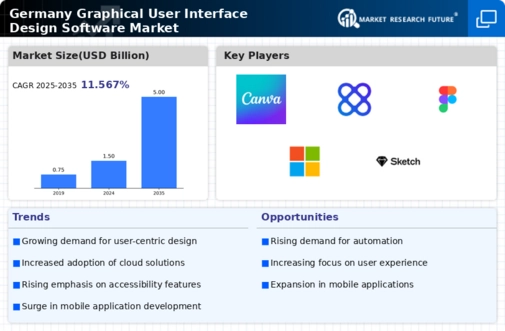The graphical user-interface-design-software market in Germany is characterized by a dynamic competitive landscape, driven by rapid technological advancements and increasing demand for user-centric design solutions. Key players such as Adobe Systems (US), Figma (US), and Sketch (US) are at the forefront, each adopting distinct strategies to enhance their market presence. Adobe Systems (US) focuses on continuous innovation, particularly through its Creative Cloud suite, which integrates AI capabilities to streamline design processes. Meanwhile, Figma (US) emphasizes collaboration and cloud-based solutions, appealing to remote teams and fostering a community-driven approach. Sketch (US), on the other hand, has carved a niche by prioritizing user experience and offering tailored solutions for mobile and web design, thereby shaping a competitive environment that thrives on innovation and user engagement.
The market structure appears moderately fragmented, with a mix of established players and emerging startups. Key business tactics include localizing software features to cater to regional preferences and optimizing supply chains to enhance service delivery. This collective influence of major players fosters a competitive atmosphere where differentiation is increasingly based on technological advancements rather than mere pricing strategies.
In October 2025, Adobe Systems (US) announced the launch of a new AI-driven feature within its design software, aimed at automating repetitive tasks for designers. This strategic move is likely to enhance productivity and attract a broader user base, reinforcing Adobe's position as a leader in the market. The integration of AI not only streamlines workflows but also aligns with the growing trend of digital transformation in design.
In September 2025, Figma (US) expanded its partnership with major tech firms to enhance its collaborative features, allowing for real-time feedback and integration with other design tools. This action underscores Figma's commitment to fostering a collaborative ecosystem, which is increasingly vital in a remote work environment. By enhancing interoperability, Figma positions itself as a go-to solution for teams seeking seamless design workflows.
In August 2025, Sketch (US) introduced a new subscription model that includes access to exclusive resources and community support. This strategic pivot aims to strengthen user loyalty and create a more engaged user community. By focusing on user experience and community-driven development, Sketch is likely to differentiate itself in a crowded market, appealing to designers who value support and resources.
As of November 2025, current competitive trends indicate a strong emphasis on digitalization, sustainability, and AI integration within the graphical user-interface-design-software market. Strategic alliances are increasingly shaping the landscape, as companies seek to leverage complementary strengths to enhance their offerings. The shift from price-based competition to a focus on innovation, technology, and supply chain reliability is evident, suggesting that future competitive differentiation will hinge on the ability to deliver cutting-edge solutions that meet evolving user needs.
















Leave a Comment